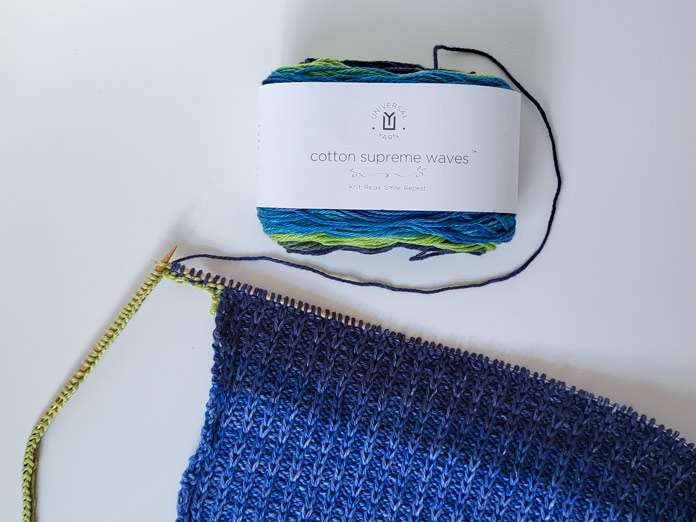As the spring cardigan converted from Ribline Pullover starts to take shape, and I completed the sleeve instructions that I wrote out (in full!) yesterday, you may have some questions. Cotton Supreme Waves is a self-striping yarn. What happens when I need to change to a new ball? How will I match the left sleeve to the right sleeve? Do I even need to color match the stripes? Well, let’s proceed to the next step in the instructions and I will guide you through some options.

Beginning to work in Slip Stitch Rib pattern over the provisional cast-on stitches at end of sleeve on a RS row.
The next instructions on the Ribline Pullover pattern are for the Body Increases.
On the pattern instructions for Ribline Pullover, it states to cast on a specific amount of stitches at the end of the next two rows that will become the (right) side seam, and thus the length of the body. But there’s a preface note before that stating: Note: Maintain newly cast on sts in Slip Stitch Rib patt. I gave that a little thought and came up with the idea of using a provisional cast-on. I used a slippery waste yarn of a similar thickness, along with the crochet hook/one-step method. There are many other methods of provisional cast-on, but if you would like to see this demonstrated look here for a tutorial by VeryPink Knits.

Beginning to work in rib pattern over the provisional cast-on stitches at end of sleeve on the next WS row.
I chose to do my cast-on with the provisional method, because I figured it would be easy to join the side seams. To join the right half and left half of the sweater at the center back, you are directed to use the 3-needle bind-off method, and I thought I should do that at these seams as well. I’ll share with you in tomorrow’s post why that might not have been the best choice. I did however remember that I cannot work the sl1 stitch in the Slip Stitch Rib pattern on the WS row over the waste yarn stitches. Because the waste yarn will be removed later, there will be no stitch there. So, I worked: p1, k2 instead, over only the cast-on sts.

Completion of the right front showing neck shaping and a new strand joined at hem edge.
Color matching when joining a new ball of self-striping Cotton Supreme Waves
Eventually, a new ball of yarn must be joined. We remember how important it is to always join a new ball at the end of a row or where a seam will be, if at all possible. That requires cutting off the length of yarn that will not make it across the next row. With self-striping yarn (also gradients) it is considered best practice to join the new ball of yarn at the same spot in the color progression. Here is what the Ribline Pullover pattern says:
Please note: Offbeat is a self-striping yarn. To ensure your project looks as close to the sample as possible, when breaking and rejoining yarn, be sure to visually color match the point at which you’re rejoining. This may require you to wind off yarn, but the results are well worth your effort.
In short, I did this. I carefully chose my next ball of Cotton Supreme Waves to start with the color I just ended with and cut off a small amount to best match the place in the stripe. I did this color matching every time I joined yarn. Yes, doing so uses more yarn.

Completion of the right half showing sleeve and front with back folded at shoulder.
Once the right half of the sweater is complete, the stitches remain open and are on hold at the center front and back. I used spare Takumi Bamboo Premium needles with Large Point Protectors at the ends to hold the large number of stitches. No changes are needed to convert the Ribline Pullover into a cardigan at this point!

Beginning the left sleeve to color match the right sleeve showing the yarn removed.
The left half of the sweater is worked same as for right half; reversing which row the neck shaping is formed. This piece will also end with the stitches remaining open and on hold at the center front and back. Tomorrow’s post will describe joining the two halves with 3-needle bind-off and how I modified the front seam into a button band.
Should the left side of the cardigan mirror the right side of the cardigan?
Answer: Only if you want it to! I did make my sides match. I deliberately chose the first ball of the second sleeve to match the first sleeve, and I still had to remove a small amount of yarn to get the stripes to start at the same point. While I worked through the left half, I color-matched all my new balls as I joined them. But if you want more random stripes, or are happy to have different-looking sides, you don’t have to color-match self-striping yarn. Cotton Supreme Waves would look fantastic either way!
